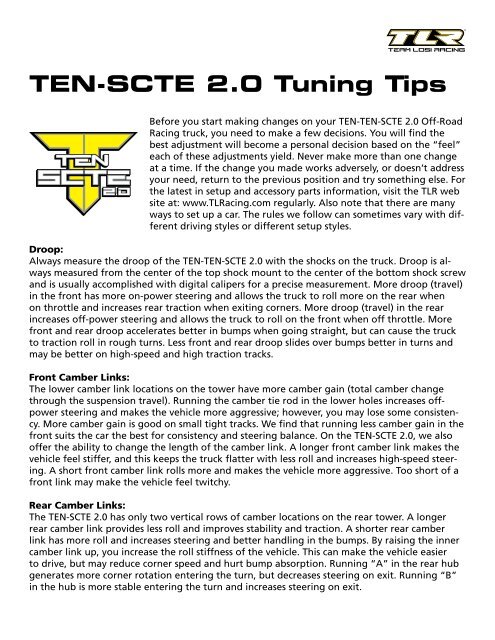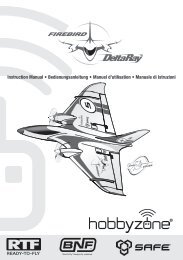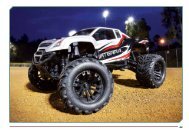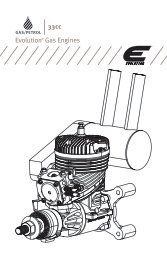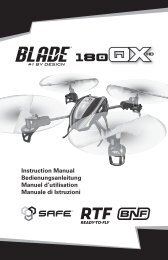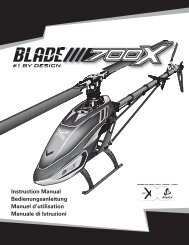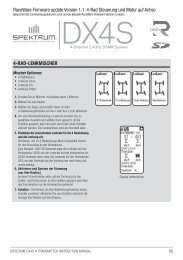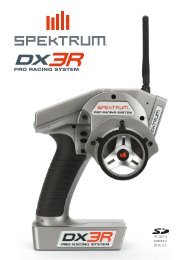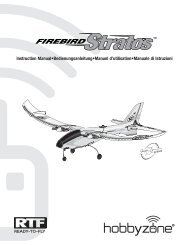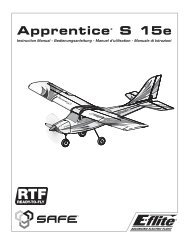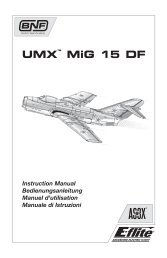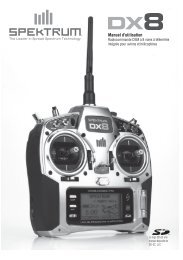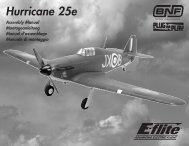TEN-SCTE 2.0 Tuning Tips - Horizon Hobby
TEN-SCTE 2.0 Tuning Tips - Horizon Hobby
TEN-SCTE 2.0 Tuning Tips - Horizon Hobby
You also want an ePaper? Increase the reach of your titles
YUMPU automatically turns print PDFs into web optimized ePapers that Google loves.
<strong>TEN</strong>-<strong>SCTE</strong> <strong>2.0</strong> <strong>Tuning</strong> <strong>Tips</strong><br />
Before you start making changes on your <strong>TEN</strong>-<strong>TEN</strong>-<strong>SCTE</strong> <strong>2.0</strong> Off-Road<br />
Racing truck, you need to make a few decisions. You will find the<br />
best adjustment will become a personal decision based on the “feel”<br />
each of these adjustments yield. Never make more than one change<br />
at a time. If the change you made works adversely, or doesn’t address<br />
your need, return to the previous position and try something else. For<br />
the latest in setup and accessory parts information, visit the TLR web<br />
site at: www.TLRacing.com regularly. Also note that there are many<br />
ways to set up a car. The rules we follow can sometimes vary with different<br />
driving styles or different setup styles.<br />
Droop:<br />
Always measure the droop of the <strong>TEN</strong>-<strong>TEN</strong>-<strong>SCTE</strong> <strong>2.0</strong> with the shocks on the truck. Droop is always<br />
measured from the center of the top shock mount to the center of the bottom shock screw<br />
and is usually accomplished with digital calipers for a precise measurement. More droop (travel)<br />
in the front has more on-power steering and allows the truck to roll more on the rear when<br />
on throttle and increases rear traction when exiting corners. More droop (travel) in the rear<br />
increases off-power steering and allows the truck to roll on the front when off throttle. More<br />
front and rear droop accelerates better in bumps when going straight, but can cause the truck<br />
to traction roll in rough turns. Less front and rear droop slides over bumps better in turns and<br />
may be better on high-speed and high traction tracks.<br />
Front Camber Links:<br />
The lower camber link locations on the tower have more camber gain (total camber change<br />
through the suspension travel). Running the camber tie rod in the lower holes increases offpower<br />
steering and makes the vehicle more aggressive; however, you may lose some consistency.<br />
More camber gain is good on small tight tracks. We find that running less camber gain in the<br />
front suits the car the best for consistency and steering balance. On the <strong>TEN</strong>-<strong>SCTE</strong> <strong>2.0</strong>, we also<br />
offer the ability to change the length of the camber link. A longer front camber link makes the<br />
vehicle feel stiffer, and this keeps the truck flatter with less roll and increases high-speed steering.<br />
A short front camber link rolls more and makes the vehicle more aggressive. Too short of a<br />
front link may make the vehicle feel twitchy.<br />
Rear Camber Links:<br />
The <strong>TEN</strong>-<strong>SCTE</strong> <strong>2.0</strong> has only two vertical rows of camber locations on the rear tower. A longer<br />
rear camber link provides less roll and improves stability and traction. A shorter rear camber<br />
link has more roll and increases steering and better handling in the bumps. By raising the inner<br />
camber link up, you increase the roll stiffness of the vehicle. This can make the vehicle easier<br />
to drive, but may reduce corner speed and hurt bump absorption. Running “A” in the rear hub<br />
generates more corner rotation entering the turn, but decreases steering on exit. Running “B”<br />
in the hub is more stable entering the turn and increases steering on exit.
<strong>TEN</strong>-<strong>SCTE</strong> <strong>2.0</strong> <strong>Tuning</strong> <strong>Tips</strong><br />
Camber:<br />
More negative camber in the front has more steering and is more responsive. Less negative camber<br />
in the front has less steering and is smoother. More negative camber in the rear has less rear<br />
traction, but increases on-power steering and is less grabby in bumps. Less negative camber in<br />
the rear has more rear traction and makes the rear of the truck stay flatter, but if traction is lost<br />
it is more violent. To ensure your <strong>TEN</strong>-<strong>SCTE</strong> <strong>2.0</strong> has the correct camber, we recommend using our<br />
Losi ® Camber Gauge (LOSA99172).<br />
1 ° Negative Camber<br />
3 ° Negative Camber 5 ° Negative Camber<br />
Front<br />
– +<br />
Steering/Responsiveness<br />
1 ° Negative Camber<br />
3 ° Negative Camber 5 ° Negative Camber<br />
Rear<br />
– +<br />
More Rear Traction/Rear of Vehicle Stays Flatter<br />
Less Traction/More On-Power Steering<br />
Front and Rear Adjustable Hinge Pin Braces:<br />
The <strong>TEN</strong>-<strong>SCTE</strong> <strong>2.0</strong> is equipped with adjustable front and rear hinge pin braces. The adjustable<br />
hinge pin braces allow the angle of the pins on the front of the vehicle to be adjusted for more<br />
or less kick, and the rear of the vehicle for more or less toe-in and anti-squat.<br />
Front Toe:<br />
You never want to run toe-in on the front of the <strong>TEN</strong>-<strong>SCTE</strong> <strong>2.0</strong>. Front toe-in (longer steering<br />
rods) decreases steering response entering in the middle of the turn, but increases on-power<br />
steering. Toe-out (shorter steering rods) increases steering response when entering the turn and<br />
increases straight line stability; however, it decreases on-power steering.
Hinge Pin<br />
A4427<br />
Front Bulkhead<br />
<strong>TEN</strong>-<strong>SCTE</strong> <strong>2.0</strong> <strong>Tuning</strong> <strong>Tips</strong><br />
Front Kick:<br />
The <strong>TEN</strong>-<strong>SCTE</strong> <strong>2.0</strong> comes with 0 inserts in the front and rear. This is a very neutral setup. Increasing the<br />
amount of kick has more off-power steering, but decreases on-power steering. Increasing the kick is<br />
A1754<br />
Front Inner Brace<br />
recommended for low-grip tracks. Decreasing the amount of kick has more on-power steering, but<br />
less off-power steering. Decreasing the amount of kick is recommended for high-grip tracks.<br />
Up Position<br />
Decrease Kick-Up<br />
Up Position<br />
Increase Kick-Up<br />
Down Position<br />
Increase Kick-Up<br />
Outer Front Brace Inner Front Brace<br />
Insert Hole Location Down Position Insert Hole Location Angle<br />
1<br />
Decrease Kick-Up<br />
Up 1 Down 12°<br />
0.5 Up 0.5 Down 11°<br />
0 NA 0 NA 10°<br />
Insert Total<br />
0.5 NumberDown Kick-Up 0.5 Up 9°<br />
1 Down 1 Up 8°<br />
Front Kick-Up Angle Adjustment<br />
Outer Front Brace Inner Front Brace<br />
Up Position<br />
Increase Kick-Up Insert Insert Insert<br />
Position Number Position<br />
Up 1° Down 1° +2°<br />
Up 0.5° Down 0.5° +1°<br />
Down Position Middle 0° Middle 0° 0°<br />
Decrease Kick-Up<br />
Down 0.5° Up 0.5° -1°<br />
Kick-Up Angle Adjustment<br />
Down 1° Up 1° -2°<br />
ace Inner Front Brace<br />
ert Insert<br />
ber • Remove Position the Bulkhead from the chassis.<br />
• Remove the existing Hinge Pin Braces and plastic covers.<br />
° Down 1° +2°<br />
• Select the desired Adjustment Cam and press it into the new Adjustable Hinge Pin Braces.<br />
° • *Note Down the position 0.5° of the number +1° on the outside of the Cam. Always install the same number Cam in the same orientation on each side<br />
° of the Middle car. 0° 0°<br />
° • Install Up the Inner Adjustable 0.5° Hinge -1° Pin Brace re-using the mounting hardware.<br />
• Align the Arms and Hinge Pins with the Adjustment Cam.<br />
° Up 1° -2°<br />
• Install the Outer Adjustable Hinge Pin Brace re-using the existing hardware.<br />
•<br />
•<br />
Re-attach the bulkhead to the chassis.<br />
Check the suspension to ensure it moves freely and does not bind.<br />
Rear Toe-in:<br />
The <strong>TEN</strong>-<strong>SCTE</strong> <strong>2.0</strong> kit setup is with 3 degrees of toe-in per side. Less rear toe-in increases the<br />
Insert Total<br />
wheel base of the truck and decreases forward traction, but increases top speed and side traction<br />
in the middle of a turn. More toe-in increases forward traction, has more off-power steer-<br />
Number Kick-Up<br />
ing and less side traction. This is adjusted by the adjustable hinge pin braces with the different<br />
inserts included with the vehicle.<br />
Rear Block<br />
Insert Hole Location Angle<br />
s.<br />
800-0329<br />
new Adjustable Hinge Pin Braces.<br />
Cam. Always install the same number Cam in the same orientation on each side<br />
e mounting hardware.<br />
m.<br />
e existing hardware.<br />
s not bind.<br />
Rear Squat:<br />
The <strong>TEN</strong>-<strong>SCTE</strong> <strong>2.0</strong> comes with three degrees of anti-squat. Running less anti-squat has less off-power<br />
steering and rolls (side to side) more on the rear. Less anti-squat accelerates better in small bumps.<br />
More anti-squat has more support (side to side) and is better on rough tracks with big jumps. This is<br />
adjusted by the adjustable hinge pin braces with the different inserts included with the vehicle.<br />
800-0329<br />
1 In 2°<br />
0.5 In 2.5°<br />
0 NA 3°<br />
0.5 Out 3.5°<br />
1 Out 4°<br />
Rear Antisquat Adjustment<br />
Insert Hole Location Angle<br />
1 Up 3°<br />
0.5 Up 2.5°<br />
0 NA 2°<br />
0.5 Down 1.5°<br />
1 Down 1°
<strong>TEN</strong>-<strong>SCTE</strong> <strong>2.0</strong> <strong>Tuning</strong> <strong>Tips</strong><br />
Wheel Base:<br />
The <strong>TEN</strong>-<strong>SCTE</strong> <strong>2.0</strong> kit setup is a long wheelbase. A shorter wheelbase (spacers behind the rear hubs)<br />
increases on-power traction, rear weight transfer, and has more off-power steering. A shorter<br />
wheelbase is better on tight or slick tracks. A longer wheelbase (spacers in front of the rear hubs)<br />
decreases off-power steering, is more stable, better in bumps, and has more on-power steering.<br />
Sway Bars:<br />
A thinner front sway bar increases front off-power traction, but has less on-power steering. A<br />
thicker front sway bar decreases front off-power traction, making the steering smoother entering<br />
the turn, but has more on-power steering. A thinner rear sway bar increases rear traction<br />
and decreases on-power steering. A thicker rear sway bar increases stability in the middle of the<br />
turn and increases on-power steering. Thicker sway bars are more stable on high-speed, hightraction<br />
tracks.<br />
Pistons:<br />
Generally smaller hole pistons have stiffer damping, slower weight transfer, slower response and<br />
lands large jumps better. Larger hole pistons have softer damping, increased traction, quicker<br />
weight transfer/response and bottom out easier off large jumps.<br />
Shock Oil:<br />
Lighter shock oil has more overall traction and responds quicker. Thicker oil has less overall traction<br />
and reacts slower. On high bite/smooth tracks, thicker oil is easier to drive. Make sure you<br />
adjust oil when there is a drastic temperature change (10º–12ºC) or (20º–25ºF). If it gets cold<br />
outside, you need to go to lighter shock oil. If it gets hotter outside, you need to go to thicker<br />
weight shock oil.<br />
Front Shock Mounting Positions:<br />
Upper—As you move out your steering will be faster and is better on bumpy surfaces.<br />
Lower—As you move out, you truck will be easier to drive and have better stability.<br />
Rear Shock Mounting Positions:<br />
Upper—As you move out you will have less mid corner grip and more traction into the corner.<br />
Lower—As you move out you will gain stability and lateral grip in turns. The inside hole will<br />
give you more traction exiting a turn.<br />
Ackerman:<br />
The long Ackerman plate has smooth off-power steering and is more forgiving. The long Ackerman<br />
plate has more steering on-power. The short Ackerman plate responds quicker and has more steering<br />
in the middle of the turn. A short Ackerman plate is better suited for tight technical tracks.<br />
Bump Steer:<br />
Running the bump steer ball down you will have smoother steering in the middle of the turn.<br />
With the bump steer ball up, you will increase steering in the middle of the turn.<br />
Ride Height:<br />
This should always be measured from a flat surface to the bottom face of the chassis. Adjust the<br />
front of the chassis with 27mm of ride height and 26mm in the rear. On high-speed tracks the<br />
<strong>TEN</strong>-<strong>SCTE</strong> <strong>2.0</strong> handles best when the front ride height is level to the rear of the truck. To measure<br />
your ride height properly, we recommend using the Losi Ride Height Gauge (LOSA99173).
<strong>TEN</strong>-<strong>SCTE</strong> <strong>2.0</strong> <strong>Tuning</strong> <strong>Tips</strong><br />
Front:<br />
Thinner front differential oil increases off-power steering, but if the oil is too thin the steering<br />
becomes grabby and inconsistent. Thicker front differential oil increases off-power stability and<br />
increases on-power steering.<br />
off-power<br />
steering increases<br />
on-power<br />
steering increases<br />
Front Diff<br />
Thin<br />
Differential oil viscosity<br />
Thick<br />
off-power<br />
on-power<br />
Center:<br />
Less steering forward increases drive—<br />
More acceleration, steering increases on-power<br />
Thinner center differential<br />
better on<br />
has<br />
rough<br />
less<br />
or slick<br />
forward<br />
tracks<br />
drive, can unload more<br />
steering<br />
under<br />
increases—better<br />
acceleration<br />
on smooth<br />
and is<br />
tracks<br />
easier to drive on rough and slick tracks. Thicker center differential has more acceleration, increases<br />
on-power<br />
Front Diff<br />
Center Diff<br />
steering Thin and less off-power Differential steering. oil viscosity Thicker center differential Thick is better on<br />
high bite/smooth tracks. Thin off-power<br />
Differential oil viscosity<br />
on-power Thick<br />
steering increases<br />
steering increases<br />
Less forward drive—<br />
More acceleration, on-power<br />
Front Diff More better cornering on rough traction— or slick tracks<br />
steering increases—better More forward traction—<br />
smooth tracks<br />
Thin increases steering in middle of Differential turn oil viscosity<br />
less steering Thick in middle of turn<br />
Center Diff<br />
Rear Diff<br />
Thin<br />
Differential oil viscosity<br />
Thick<br />
Thin Less forward drive— Differential oil viscosity<br />
More acceleration, Thick on-power<br />
better on rough or slick tracks<br />
steering increases—better on smooth tracks<br />
Rear:<br />
More cornering traction—<br />
More forward traction—<br />
Thinner rear differential has more corning traction and increases steering in the middle of the<br />
Center increases steering in middle of turn<br />
less steering in middle of turn<br />
turn. Thicker<br />
Diffrear differential has less steering in the middle of the turn and more forward<br />
Thin<br />
Differential oil viscosity<br />
Thick<br />
traction.<br />
Rear Diff<br />
Rear Diff<br />
Thin<br />
Differential oil viscosity<br />
More cornering traction—<br />
increases steering in middle of turn<br />
Thin<br />
Differential oil viscosity<br />
Thick<br />
More forward traction—<br />
less steering in middle of turn<br />
Thick<br />
Gearing:<br />
The <strong>SCTE</strong> <strong>2.0</strong> uses a 43-tooth ring gear with an 11-tooth pinion<br />
gearing, giving the car a drive ratio of 3.91:1. The truck comes<br />
stock with a 40-tooth MOD 1 spur gear. When gearing, it is important<br />
to consider the track, the ambient temperature, and the<br />
temperature of your electronics. As you gear up, this will make<br />
your electronics warmer and typically give you more top speed for<br />
larger, more sweeping tracks. For smaller tracks or tracks where<br />
more torque is needed, or if your electronics are too warm, you<br />
will want to gear down.<br />
Final Drive Ratio<br />
Pinion<br />
Spur 40<br />
12 13.03:1<br />
13 1<strong>2.0</strong>3:1<br />
14 11.17:1<br />
15 10.43:1<br />
16 9.78:1<br />
17 9.20:1<br />
18 8.69:1<br />
19 8.23:1<br />
20 7.82:1
<strong>TEN</strong>-<strong>SCTE</strong> <strong>2.0</strong> <strong>Tuning</strong> <strong>Tips</strong><br />
Name:<br />
Date:<br />
Event:<br />
City:<br />
State:<br />
Track:<br />
Track<br />
Conditions<br />
Indoor<br />
Outdoor<br />
Tight<br />
Open<br />
Smooth<br />
Rough<br />
Hard Packed<br />
Loose/Loamy<br />
Blue Groove<br />
Dry<br />
Wet<br />
Dusty<br />
Grass<br />
Astro Turf<br />
Low Bite<br />
Med Bite<br />
High Bite<br />
Other<br />
Front Suspension<br />
Toe:<br />
Ride Height:<br />
Camber:<br />
Steering Ackerman:<br />
Sway Bar:<br />
Shock Type: Bladder<br />
Piston:<br />
Spring:<br />
Limiter/Droop:<br />
Overall Shock Length:<br />
Shock Location:<br />
Bump Steer:<br />
Camber Link:<br />
Front Diff Fluid:<br />
Center Diff Fluid:<br />
Emulsion Oil:<br />
Notes:<br />
4<br />
3<br />
2<br />
1<br />
4<br />
3<br />
2<br />
1<br />
Inside<br />
Center<br />
Outside<br />
Rear Suspension<br />
Toe:<br />
Anti-Squat:<br />
Ride Height:<br />
Camber:<br />
Rear Hub Spacing:<br />
Sway Bar:<br />
Shock Type: Bladder<br />
Piston:<br />
Spring:<br />
Limiter/Droop:<br />
Camber Link:<br />
Shock Locations:<br />
Overall Shock Length:<br />
Rear Diff Fluid:<br />
Battery Position:<br />
Weight Placement<br />
(Mark with “X”)<br />
Emulsion Oil:<br />
Tires<br />
Front:<br />
Electronics<br />
Radio:<br />
Servo:<br />
ESC:<br />
Initial Brake:<br />
Drag Brake:<br />
Throttle Profile:<br />
b<br />
Timing Advance:<br />
Throttle/Brake Expo:<br />
Servo Expo:<br />
Throttle/Brake EPA:<br />
Motor:<br />
Pinion: Spur:<br />
Battery:<br />
Compound Insert Additive<br />
a<br />
Inside<br />
Center<br />
Outside<br />
3<br />
2<br />
1<br />
4<br />
3<br />
2<br />
1<br />
Rear:<br />
Weight of<br />
each piece<br />
oz./g<br />
Notes:


